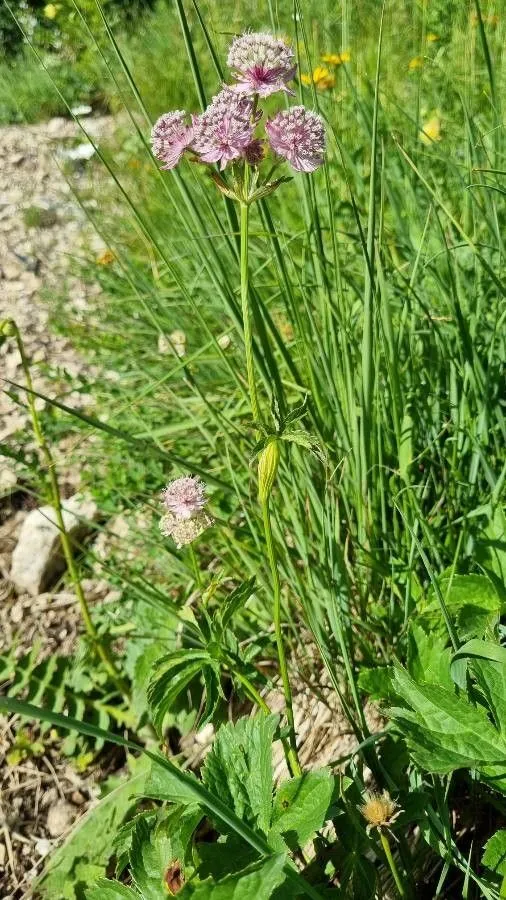
Author: L.
Bibliography: Sp. Pl.: 235 (1753)
Year: 1753
Status: accepted
Rank: species
Genus: Astrantia
Vegetable: False
Observations: C. & S. Europe to N. Caucasus
Astrantia, known scientifically as Astrantia major, is a captivating plant that graces gardens and natural landscapes with its unique charm. Authoritatively documented in the seminal work “Species Plantarum” in 1753 by the renowned botanist Carl Linnaeus, Astrantia major belongs to the Apiaceae family, a group known for its diverse and often aromatic members.
The natural habitat of Astrantia spans across Central and Southern Europe, reaching as far east as the Northern Caucasus. This geographical distribution highlights the plant’s adaptability to different environments, from the cool, temperate climates of Europe to the more varied climates found in the Caucasus region.
Astrantia is particularly prized for its distinctive floral architecture. The plant’s flowers are composed of numerous small umbels surrounded by petal-like bracts, creating an almost starburst appearance that draws the eye and intrigues the botanically inclined. These bracts are typically in shades ranging from white to pink to deep red, providing an exquisite palette that can complement a variety of garden designs.
In its native regions, Astrantia often thrives in moist, semi-shaded areas, frequently found flourishing in meadows and woodland clearings. The plant’s ability to thrive in such conditions makes it a versatile addition to many garden settings, where it can add a touch of the wild and the beautiful.
Astrantia major not only serves an aesthetic purpose but also supports local ecosystems. It attracts a range of pollinators, including bees, butterflies, and other beneficial insects, thereby playing a crucial role in sustaining biodiversity within its habitat.
Cultivating Astrantia in a garden setting can be a rewarding experience. It prefers fertile, well-draining soil and benefits from being planted in areas that receive partial shade. Regular watering is essential to maintain its lush appearance, especially during dry spells, ensuring the plant remains a striking feature from late spring through early autumn.
To garden enthusiasts and botanists alike, Astrantia major offers both visual delight and ecological value, embodying the inherent beauty and complexity of nature. Its enduring charm and versatility make it a timeless addition to gardens, appealing to those who appreciate the finer details of plant life.
Eng: astrantia, greater masterwort, great masterwort, mountain sanicle, pink masterwort
Deu: große sterndolde, große sterndolde i.w.s.
Dan: gulgrå museurt, håret kortstråle, kugle-museurt, stjerneskærm, stor stjerneskærm
Nor: gulgrå ullurt, kule-ullurt, peruskjelfrø
Swe: gulgrå ullört, gängel, klotulllört, isotähtiputki, stjärnflocka, östbinka, stjärnfloka, stjärnloka
Fin: saksantuulenlento, tarhasaurikki, isotähtiputki
Lav: liela zvaigznite
Nno: stjerneskjerm
Nob: stjerneskjerm
Est: suur tähtputk
Nld: groot sterrenscherm
Fra: grande astrance
Cym: astrantia
Lat: astrantia
En: Astrantia, Greater masterwort, Great masterwort, Mountain Sanicle, Pink Masterwort
Be: Астранцыя вялікая
Bg: Зарниче
Ca: Astrància gran, Astrància major
Zh: 大星芹
Cs: Jarmanka větší, Jarmanka
Da: Stor Stjerneskærm, Gulgrå Museurt, Håret Kortstråle, Kugle-Museurt, Stjerneskærm
Nl: Groot sterrenscherm, Zeeuws Knoopje, Groot Sterrescherm
Et: Suur tähtputk
Fi: Isotähtiputki, Saksantuulenlento, Tarhasaurikki
Fr: Grande astrance, Grande radiaire, Astrancée, Sanicle femelle, Grande Astrantie
Ka: Ვარსკვლავა
De: Grosse Sterndolde, Große Sterndolde, Schwarzer Sanikel, Sternblume, Große Sterndolde i.w.S., Kaiserwurz, Meisterwurz
Hu: Nagy völgycsillag, Völgycsillag
It: Astranzia maggiore
La: Astrantia
Lv: Liela zvaigznite
Lt: Didžioji astrantija
Mk: Голема ѕвезда
No: Gulgrå ullurt, Kule-ullurt, Peruskjelfrø
Nb: Stjerneskjerm
Nn: Stjerneskjerm
Fa: ستارهگون مهتر
Pl: Jarzmianka większa
Ru: Астранция большая, Астранция крупная
Sk: Jarmanka väčšia
Es: Sanicula hembra, Astrancia, Sanícula hembra
Sv: Stjärnflocka, Linnes fröknar, Linnés fröknar, Gulgrå ullört, Gängel, Klotulllört, Isotähtiputki, Östbinka, Stjärnfloka, Stjärnloka
Zh-tw: 大星芹
Tr: Havaifişek çiçeği
Uk: Астранція велика, Гоюче зілля, Напрасниця
Cy: Astrantia
Taken Jul 21, 2020 by Jean-Claude Lainé (cc-by-sa)
Taken Jul 7, 2018 by Naldi Monica (cc-by-sa)
Taken Aug 15, 2018 by Víctor Huete (cc-by-sa)
Taken Jul 15, 2018 by Sabine Crépé (cc-by-sa)
Taken May 31, 2020 by Jean Giordano (cc-by-sa)
Taken Jul 2, 2019 by lynn lynn (cc-by-sa)
Taken Jun 15, 2020 by Defu Wang (cc-by-sa)
Taken Jun 15, 2020 by Defu Wang (cc-by-sa)
Taken Aug 10, 2021 by Lennaert Steen (cc-by-sa)
Taken Jul 15, 2021 by Jani Zadrgal (cc-by-sa)
Taken Aug 10, 2021 by Lennaert Steen (cc-by-sa)
Taken Sep 8, 2021 by Jacques Zuber (cc-by-sa)
Taken Aug 19, 2021 by Jacques Zuber (cc-by-sa)
Taken Jul 15, 2021 by Jani Zadrgal (cc-by-sa)
Taken Jul 25, 2020 by Mazzi Moreno (cc-by-sa)
Taken May 8, 2017 by Yoan MARTIN (cc-by-sa)
Taken Sep 30, 2022 by manuseitz (cc-by-sa)
Taken Sep 30, 2022 by manuseitz (cc-by-sa)
Taken Jun 11, 2017 by Yoan MARTIN (cc-by-sa)
Taken Aug 14, 2020 by Christelle Zanne (cc-by-sa)
Taken Jul 22, 2011 by Tela Botanica − Yoan MARTIN (cc-by-sa)
Taken Jun 29, 2013 by Tela Botanica − Paul FABRE (cc-by-sa)
Taken Jul 22, 2011 by Tela Botanica − Yoan MARTIN (cc-by-sa)
Taken Jul 11, 2010 by Tela Botanica − Yoan MARTIN (cc-by-sa)
Taken May 25, 2022 by Teun (cc-by-sa)
Taken Jun 9, 2021 by Martine Hoendervanger (cc-by-sa)
Taken Jun 28, 2021 by Ren Banner (cc-by-sa)
Taken Jun 15, 2014 by Tela Botanica − Liliane Roubaudi (cc-by-sa)
Taken Jun 15, 2014 by Tela Botanica − Liliane Roubaudi (cc-by-sa)
Taken Jul 8, 2021 by Leandro Martins Santos (cc-by-sa)
© copyright of the Board of Trustees of the Royal Botanic Gardens, Kew.
© copyright of the Board of Trustees of the Royal Botanic Gardens, Kew.
© copyright of the Board of Trustees of the Royal Botanic Gardens, Kew.
Growth habit: Forb/herb
Ph maximum: 7.0
Ph minimum: 6.5
Light: 6
Atmospheric humidity: 5
Bloom months: [‘jun’, ‘jul’, ‘aug’]
Soil nutriments: 6
Family: Myrtaceae Author: (F.Muell.) K.D.Hill & L.A.S.Johnson Bibliography: Telopea 6: 402 (1995) Year: 1995 Status:…
Family: Rubiaceae Author: Pierre ex A.Froehner Bibliography: Notizbl. Bot. Gart. Berlin-Dahlem 1: 237 (1897) Year:…
Family: Sapindaceae Author: Koidz. Bibliography: J. Coll. Sci. Imp. Univ. Tokyo 32(1): 38 (1911) Year:…
Family: Asteraceae Author: A.Gray Bibliography: Pacif. Railr. Rep.: 107 (1857) Year: 1857 Status: accepted Rank:…
Family: Fabaceae Author: Medik. Bibliography: Vorles. Churpfälz. Phys.-Ökon. Ges. 2: 398 (1787) Year: 1787 Status:…
Family: Aspleniaceae Author: (Cav.) Alston Bibliography: Bull. Misc. Inform. Kew 1932: 309 (1932) Year: 1932…